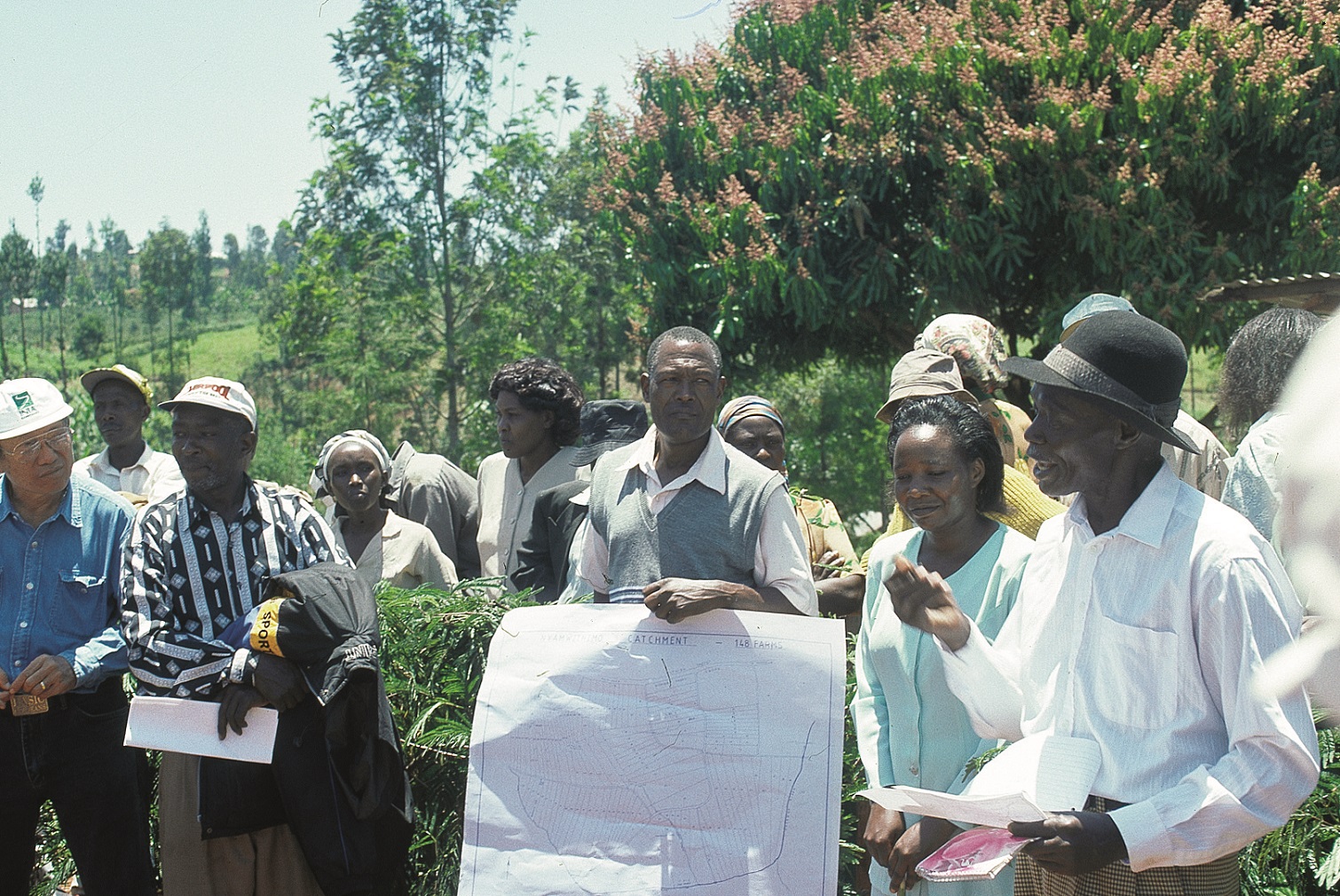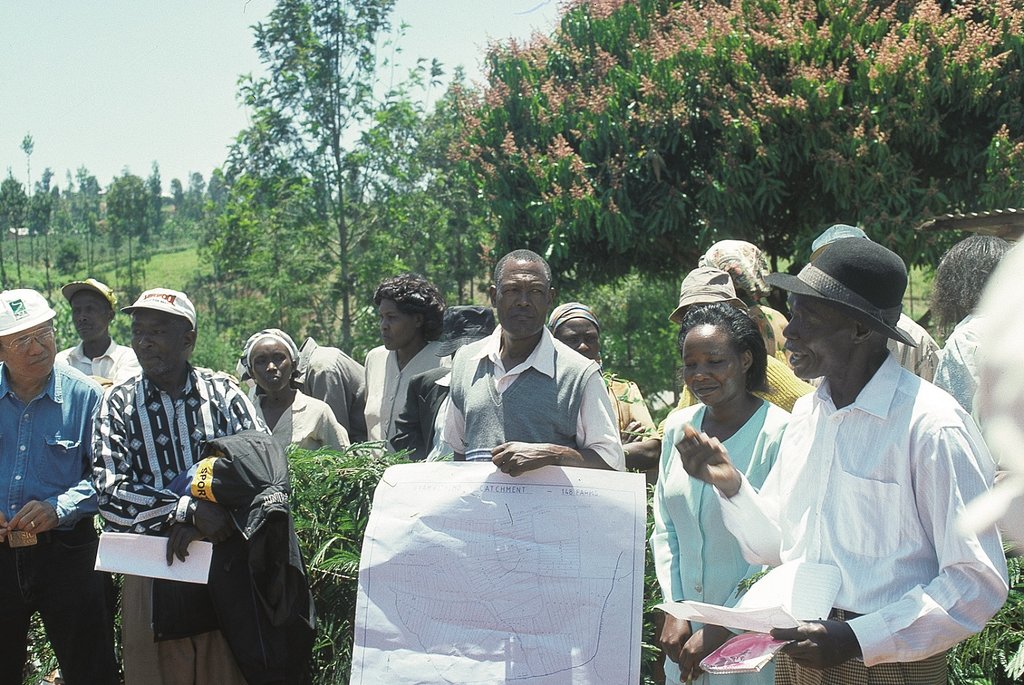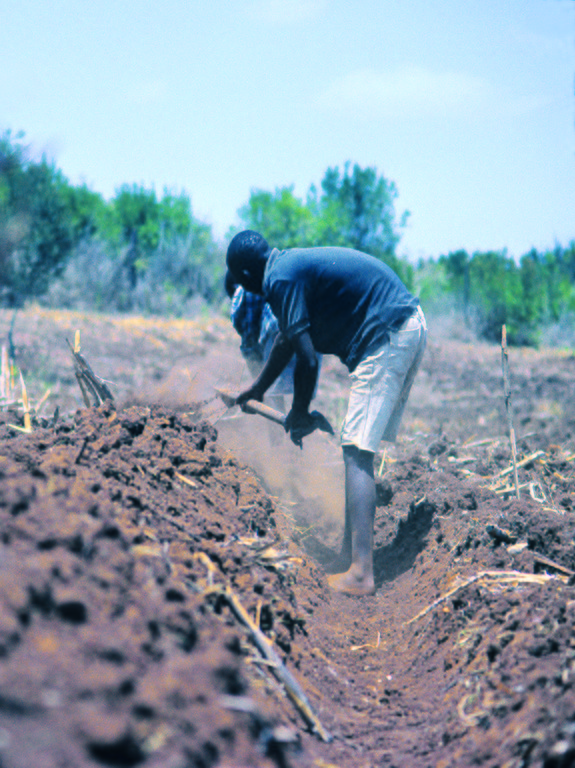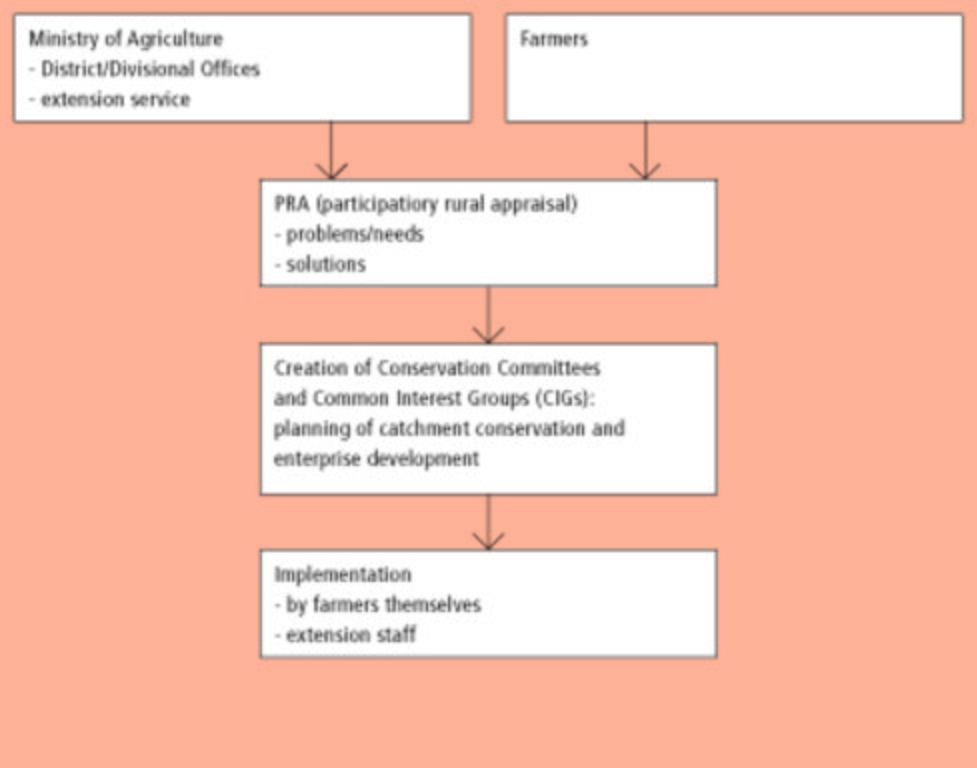Catchment Approach [كينيا]
- تاريخ الإنشاء:
- تحديث:
- جامع المعلومات: Deborah Niggli
- المحرر: –
- المُراجع: Deborah Niggli
approaches_486 - كينيا
عرض الأقسام
توسيع الكل طي الكل1. معلومات عامة
1.2 تفاصيل الاتصال بالأشخاص الرئيسيين لمصدر المعلومات والمؤسسات المعنية بتقييم وتوثيق النهج
متخصص في الإدارة المستدامة للأراضي:
1.3 الشروط المتعلقة باستخدام البيانات الموثقة من خلال WOCAT
يوافق جامع المعلومات والشخص (لاشخاص) الرئيسي لمصدر المعلومات على الشروط المتعلقة باستخدام البيانات الموثقة من خلال WOCAT:
نعم
2. وصف نهج الإدارة المستدامة للأراضي
2.1 وصف موجز للنهج
A focused approach to integrated land and water management, including soil and water conservation, where the active participation of the villagers - often organised through common interest groups - is central.
2.2 وصف تفصيلي للنهج
وصف تفصيلي للنهج:
The catchment approach promotes sustainable land management systems by conservation of a defined area (so-called 'micro-environments') through the active participation of the communities living there. It was launched in Kenya in 1988 to achieve greater technical and social impact - and at a more rapid pace - than the previous focus on individual farmers. This case focuses on a single 'catchment' in a subhumid area of Central Kenya. The emphasis is on structural measures - especially fanya juu terraces - but vegetative systems are promoted also. Other activities are supported such as spring protection, improved crop and animal husbandry, agroforestry, fodder production, fish ponds and others. The specific objectives are to stimulate the implementation of a variety of SWC measures leading simultaneously to improved production. Each approach area is defined by cultural/administrative boundaries rather than strict hydrological watersheds or catchments (as its name confusingly implies).
A conservation committee is elected from amongst the focal community before problem identification begins. Technical staff from relevant government and non-government agencies (NGOs) are co-opted onto the committee. The approach then involves participatory methods of appraisal and planning of solutions. Land users, together with the co-opted subject matter specialists, pool their knowledge and resources. Common Interest Groups (CIGs) are formed, with the aim of self-help promotion of specific farm enterprises. Training is given to the members of the CIGs by the Ministry of Agriculture. The farmers carry out the majority of the work themselves: monetary or other tangible incentives are few. The end result is the micro-environment (catchment area) conserved for improved production, and left in the hands of the community to maintain and sustain.
The catchment approach was developed under the National Soil and Water Conservation Programme - supported by (Swedish) Sida - and continues to be promoted as the Focal Area Approach (FAA) under the National Agricultural and Livestock Extension Programme (NALEP), which is again supported by Sida. However, under NALEP there is less emphasis on soil and water conservation than the previous programme, and more focus on promotion of productive enterprises.
2.3 صور عن النهج
2.5 البلد/المنطقة/المواقع التي تم تطبيق النهج فيها
البلد:
كينيا
مزيد من التفاصيل حول الموقع:
Muranga District
2.6 تواريخ بدء وإنهاء تنفيذ النهج
أشر إلى سنة البدء:
1987
سنة الإنهاء (إذا لم يعد النهج مطبقًا):
2000
2.7 نوع النهج
- قائم على مشروع/برنامج
2.9 الظروف التي تمكن أو تعيق تنفيذ التقنية/التقنيات المطبقة بموجب النهج
توفر/الوصول إلى الموارد والخدمات المالية
- معيق
Lack of capital hinders farmers from investing in structures. Group work must be encouraged.
المعرفة حول الإدارة المستدامة للأراضي، والوصول إلى الدعم الفني
- معيق
Lack of conservation knowledge. Training through courses and field days enhancing knowledge spreading of SLM.
3. المشاركة وأدوار الأطراف المعنية
3.1 أصحاب المصلحة المعنيون بالنهج وأدوارهم
- مستخدمو الأراضي المحليون/المجتمعات المحلية
- متخصصون في الإدارة المستدامة للأراضي / مستشارون زراعيون
- المعلمون / أطفال المدارس / الطلاب
- الحكومة الوطنية (المخططون، صانعو القرار)
3.3 مخطط التدفق (إذا كان متاحًا)
3.4 اتخاذ القرار بشأن اختيار تقنية/تقنيات الإدارة المستدامة للأراضي
حدد من الذي قرر اختيار التقنية/التقنيات التي سيتم تنفيذها:
- مستخدمو الأراضي بشكل أساسي، بدعم من متخصصي الإدارة المستدامة للأراضي
4. الدعم الفني وبناء القدرات وإدارة المعرفة
4.1 بناء القدرات/التدريب
هل تم تقديم التدريب لمستخدمي الأراضي / الأطراف المعنيين الآخرين؟:
نعم
حدد من تم تدريبه:
- مستخدمو الأراضي
- extensionists/trainers, school children/students, teachers
شكل التدريب:
- من مزارع إلى مزارع
4.2 خدمة استشارية
هل يملك مستخدمو الأراضي وصولا إلى خدمة استشارية؟:
نعم
حدد ما إذا كانت الخدمة الاستشارية متوفرة:
- في حقول مستخدمي الأراضي
4.3 تعزيز المؤسسات (التطوير التنظيمي)
هل تم إنشاء أو تعزيز مؤسسات من خلال هذا النهج؟:
- نعم، باعتدال
حدد المستوى (المستويات) التي تم فيها تعزيز أو إنشاء المؤسسات:
- محلي
حدد نوع الدعم:
- بناء القدرات/التدريب
4.4 الرصد والتقييم
هل يشكل الرصد والتقييم جزءا من النهج؟:
نعم
5. التمويل والدعم المادي الخارجي
5.1 الميزانية السنوية لمكون الإدارة المستدامة للأراضي في النهج المذكور
إذا لم تكن الميزانية السنوية الدقيقة معروفة، قم بالإشارة إلى نطاقها:
- < 2000
5.2 الدعم المالي/المادي المقدم لمستخدمي الأراضي
هل حصل مستخدمو الأراضي على دعم مالي/ مادي لتنفيذ التقنية/ التقنيات؟:
كلا
5.3 إعانات لمدخلات محددة (بما في ذلك العمالة)
- معدات
| حدد المدخلات التي تم دعمها | إلى أي مدى | حدد الإعانات |
|---|---|---|
| أدوات | Given to catchment committee for use in catchment. | |
- زراعة
| حدد المدخلات التي تم دعمها | إلى أي مدى | حدد الإعانات |
|---|---|---|
| بذور | Tree seeds for group nursery establishment. | |
إذا كان العمل من قبل مستخدمي الأراضي مدخلاً جوهريًا، فهل كان:
- تطوعي
5.4 الائتمان
هل تم توفير ائتمان في إطار نهج أنشطة الإدارة المستدامة للأراضي؟:
كلا
6. تحليل الأثر والتصريحات الختامية
6.1 آثار النهج
هل ساعد النهج مستخدمي الأراضي على تنفيذ وصيانة تقنيات الإدارة المستدامة للأراضي؟:
- لا
- نعم، قليلا
- نعم، باعتدال
- نعم، إلى حد كبير
The improvements to SWC are moderate: these have been mainly through fanya juu and level bench terraces.
هل أدى النهج إلى تحسين معرفة وقدرات مستخدمي الأراضي على تنفيذ الإدارة المستدامة للأراضي؟:
- لا
- نعم، قليلا
- نعم، باعتدال
- نعم، إلى حد كبير
Interventions are likely to continue and be maintained, but this depends on common interest groups continuing to function actively.
6.2 المحفز الرئيسي لقيام مستخدمي الأراضي بتنفيذ الإدارة المستدامة للأراضي
- زيادة الإنتاج
- زيادة الربح (القدرة)، وتحسين نسبة التكلفة إلى العائد
- الانتماء إلى حركة/ مشروع/ مجموعة/ شبكات
6.3 استدامة أنشطة النهج
هل يمكن لمستخدمي الأراضي المحافظة على استدامة ما تم تنفيذه من خلال النهج (بدون دعم خارجي)؟:
- نعم
6.4 نقاط قوة/مزايا النهج
| نقاط القوة/ المزايا/ الفرص من وجهة نظر مستخدمي الأراضي |
|---|
| New and productive farm enterprises have been promoted under the catchment approach alongside better SWC |
| Much improved extension/training - research linkages have been forged |
| نقاط القوة/ المزايا/ الفرص من وجهة نظر جامع المعلومات أو غيره من الاشخاص الرئيسيين لمصدر المعلومات |
|---|
| There is evidence of 'ownership' by the community which implies a feeling that what has been achieved is due to communal efforts and belongs to them |
| Genuine community participation has been achieved under this approach |
6.5 نقاط الضعف/ العيوب في المنهج وطرق التغلب عليها
| نقاط الضعف/ المساوىء/ المخاطر من وجهة نظر مستخدم الأراضي | كيف يمكن التغلب عليها؟ |
|---|---|
| Lack of material incentives like seeds and fertilizers | assist the farmers with the credit. |
| نقاط الضعف/ المساوىء/ المخاطر من وجهة نظر جامع المعلومات أو غيره من الاشخاص الرئيسيين لمصدر المعلومات | كيف يمكن التغلب عليها؟ |
|---|---|
| In many places there is a lack of availability of inputs | Provide better credit facilities for CIGs/farmers generally. |
| Technologies tend to be implemented uniformly, not site-specifically | SWC practices should be matched to each particular situation, eg structural measures such as fanya juu terraces should be promoted only where necessary, that is where agronomic and vegetative measures do not provide sufficient protection. |
| As yet uncertainty about continuation in specific areas if direct support stops after only one year | Don't abruptly terminate this support after one year: continue approach for at least two or three years in each catchment (approach area). |
7. المراجع والروابط
7.1 طرق جمع/مصادر المعلومات
- زيارات ميدانية، مسوحات ميدانية
- مقابلات مع مستخدمي الأراضي
الروابط والوحدات المواضيعية
توسيع الكل طي الكلالروابط
لا يوجد روابط
الوحدات المواضيعية
لا يوجد وحدات مواضيعية





